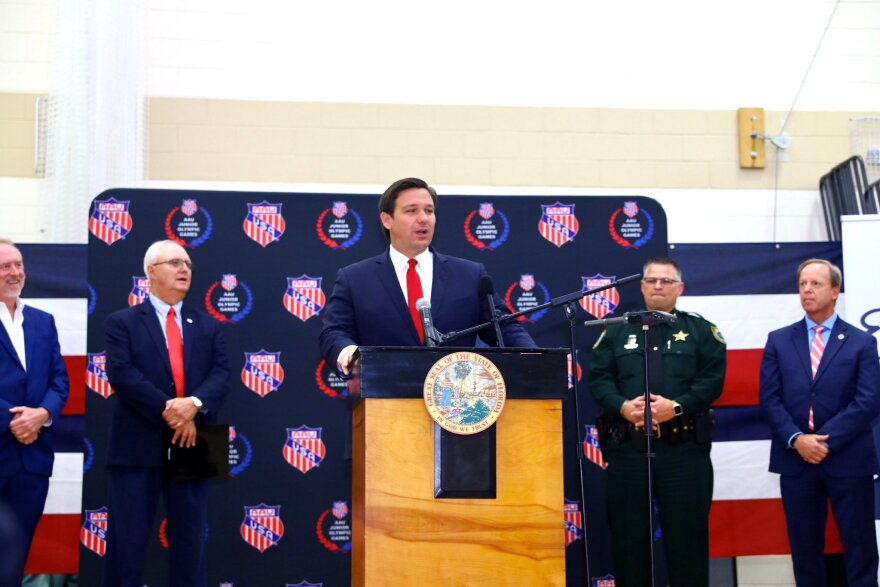Gov. Ron DeSantis is out with a plan to reopen Florida’s public schools at full capacity this fall, regardless of the status of the coronavirus pandemic.
Developed by the Re-Open Florida Task Force in conjunction with the Florida Department of Health and the CDC, the plan provides a "road map" to support health and safety measures -- despite the continued rise in the number of COVID-19 patients statewide. But those cases, he contends, are not indicative of any clinical consequence.
“For example, our hospitalizations are flat; ICU use is half of what it was in April for this,” said the governor. “And if you also look at the fatalities in Florida, the general public – meaning people who aren’t in long-term care facilities – the peak fatality date for that was the second week of April.”
The governor contends that schools fall outside the inner circle of industries considered to be most at-risk for coronavirus – such as long-term care facilities, prisons, and in agriculture. He adds that the data show most deaths have been age 85 and above.
“And I think the data is [sic] in on this, in terms of the risk of kids to this; we haven’t had a single 0-18 fatality, COVID-related,” DeSantis said. “The risk to kids is significantly lower than it is for influenza – both in terms of hospitalization and fatalities.”
“I think [DeSantis] is on the right track; most educators are going to recognize that the best way to teach students is in a face-to-face environment; and, as in all activities in life, there’s always going to be some risk,” said Escambia County School Superintendent Malcolm Thomas.
Many of the items listed in the plan are doable, says Thomas, such as allowing local school district and health officials call the shots.

“And when those decisions are made, they can be very focused; for example, if you have a positive COVID case in a particular classroom, you can isolate the students in the class,” Thomas said. “Maybe they stay home for a few days, and work remotely. It could be temporary, and the rest of the school can function.”
Or, if there are massive cases at an individual school, it could be quarantined without affecting the rest of the district. Thomas calls that a “much more reasoned approach” to get the kids in class and their parents back to work and their lives back on track. But he concedes, some adjustments are in order – such as no more water fountains.
“We’re going to replace them eventually with bottle-filling stations; we’re obviously going to wash hands more,” said Thomas. “We’ll try to distance where we can. There are some places where we’re not going to be able to do 6 ft. Part of what students learn in school – how to get along with others, how to work in a group – we’ll just have to adjust where we can.”
DeSantis’ plan will be supported with about $1 billion from the $2.2 trillion federal Coronavirus Aid, Relief and Economic Security -- or CARES -- Act, passed by Congress in March. The governor says it will help narrow what he calls “the achievement gap” brought about by the distanced learning forced by the pandemic.
“I think a lot of students fell behind during this period; I think Florida did as good of a job as we could in mitigating that,” said the governor. “But at the end of the day, distance learning is distance learning. And there’s no substitute for that hands-on instruction.”
Escambia Superintendent Malcolm Thomas applauds that part of the program, saying his district will try to participate in the areas that make the most sense to them.
“Some students may have thrived in the virtual, but the truth is no student received their full complement of instruction during April and May,” Thomas said. “You just can’t sit in front of a computer for six, six and a half hours, like we had them in school face-to-face for six hours.”
It appears high school athletics will return in the fall, but in what form remains up in the air. Thomas says the phase-in begins next week.
“Effective June 15, all of our students should have their physicals and paperwork completed,” said Thomas. “They’ll be able to work out in the weight rooms, they’ll start conditioning. Most of these athletes, they’re out of shape; they have not really worked out since mid-March.”
Meanwhile, the state’s 67 districts are awaiting word from the Florida High School Athletic Association, on when the football and volleyball seasons can begin.
“I do believe we will have football in the fall; it may not start before Labor Day, but I’m OK with that,” said Thomas. “I’ve always felt that playing football in August, it’s too hot and we want to put [the] safety of our students first. If we could push it back to Labor Day and play later into November, I’m OK with that. I think it’s a good move.”
And football games likely will not be played before empty seats, predicts Thomas. He believes that the recovery from the pandemic will be in “at least’ Phase-3 in August and early September – which would allow large groups, but still wearing masks.

